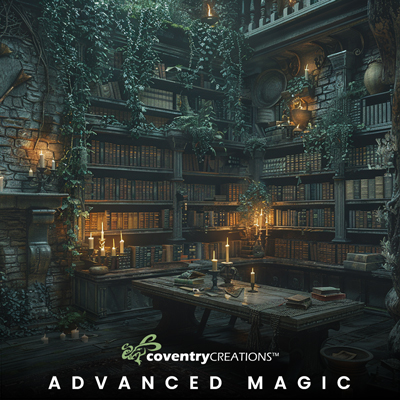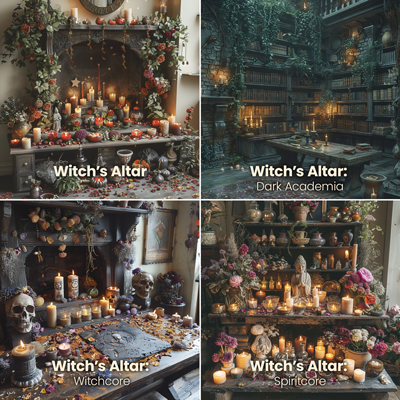![]()
930 East Lewiston Ave.
Ferndale, MI 48220
+1 (313) 924-3815

 Recently, many witches have taken to believing that witchcraft is not possible without amazing aesthetics. This is simply false and history proves it time and again.
Recently, many witches have taken to believing that witchcraft is not possible without amazing aesthetics. This is simply false and history proves it time and again.Where did this argument start? I could be wrong here, but I blame the Harry Potter franchise for giving us the Dark Academia look, and recent movies like VVITCH and The Love Witch. I also blame Tumblr, Reddit, Pinterest, Threads, Instagram, and TikTok. You’ve likely seen hashtags like #witchtok and #witchaesthetic if you’re reading this article. These social networks seem to comprise the lion's share of the arguments.
And finally the most beloved of AI-generators: Midjourney for making impossibly perfect witchy cottages with potions and bones, all together with lighting that would make many Hollywood directors drool. The images for this article were all generated with Midjourney.
While there are literally thousands, let’s narrow it down to the top three.
Let me be clear. I love some of the new aesthetics of witchcraft. Hell, I loved the old Middle Ages aesthetics, too. The aesthetics are often what draws many to the Craft. There are some truly beautiful altars being made, and some beautiful, dark, apothecary-style imagery (admittedly, most of it is AI-generated) but what does this have to do with performing actual witchcraft? The answer is, frustratingly, “it depends.”

First there is the camp of “Aesthetics don’t matter.” This is a very strong point of view for many reasons:
1. Witchcraft is often performed outdoors and that means dirt. Oftentimes it means lying in the dirt or against trees, or putting your bare feet in the water or mud while you amble about looking for swamp flowers.
2. Spells often involve all sorts of messy ingredients, from graveyard dirt to lodestone shavings, red brick dust, four thieves vinegar, herbs, powders, oils, candles, to bones, animal parts, wood shavings, blood, and ink, there are so many ways to get dirty in the Craft.
3. Some deities and many of the spirits of the land prefer a dirty aesthetic. Certainly the Warrior Orishas (Elegba, Ogún, and Ochosí) of the Afro-Caribbean traditions do. Priests of Elegba and Ogún can get downright cranky if you try to clean their Warriors. Likewise, the Dead are often attracted to dusty homes, dirty corners, cobwebs — and especially — leaky sinks and bathtubs. The Orisha Asojano (also known as Babalu Ayé) is the Orisha of infectious diseases, especially smallpox, malaria, and leprosy. In Voudon, Baron Samedi likes his offerings on a dirt floor.
The Aztec goddess, Tlazōlteōtl, has an aspect called Tlahēlcuāni, which means “She who eats filthy excrescence or sin.”
Many Chthonic and war-based European deities also like griminess. Hekate, in her aspect as the Filth Eater (Borborophorba), is all about the earth, corpses, remains, worms, and the grave. The Morrigan often appear as three crows on the battlefield, eating the eyes and entrails of the slain. The Roman god, Sterquilinus, is probably the ultimate example. His name means manure and he is literally the god of fecal matter.
My friend, author and editor Lisa Morris, is a trusted expert in this area and explained to me that there are several entities that, while not dirty per se, don’t mind a messy or disorganized aesthetic, including Ymir, Ptah, Hephaestus, and Prometheus. I would add that Eris/Discordia, while elegant goddesses, are all about chaos and silliness on their altars. And Loki? Tell me he wouldn’t appreciate pranks and magic tricks on his altar.
4. It’s really about intention and the working — not how it looks. This one is very hard to argue against. When most of your spell is spent with your eyes closed, how important is the aesthetic?
5. Better aesthetics don’t guarantee better results. The subtle nature of spells makes any type of measurement or analytics a waste of time and impossible to prove one way or the other.
Good arguments, all. But not so fast. There are some equally powerful examples on the other side.
Now we move to the camp of “Aesthetics Matter.” This too, is a very strong point of view for many reasons:
1. A witchy aesthetic can get you in the right headspace. There is a lot of psychological evidence to support this. Yoga teachers know this and take great pains to ensure their studios feel calm, safe, clean, and comfortable. Having a dedicated part of your house — or entire room, if you’re lucky enough — that has a distinctly different aesthetic can instantly make you enter that headspace, making meditation, spellcasting, and, and spellcrafting easier,
2. A witchy aesthetic can change the vibration of that part of your home. Having all of your magical tools, books, and altars in one place (or many) creates a vibrational change to that area that spirits respect, deities and demons respond to, and
3. There are deities and spirits who insist on cleanliness. This is especially true in their altar spaces. Obatala, the Orisha whose name literally means “King of the White Cloth” demands a clean, white altar. My own Orisha, Yemója, loves having a beautiful altar, and I am constantly tweaking and rearranging her shells, mermaid figurines, shark teeth, and nautical décor. Lisa Morris also informs me that many of the Goetic daemons are quite appreciative when anyone does something for them that was done out of sincere respect and gratitude, and that daemons like Andras are constantly cleaning and polishing their weapons.
4. Many ancestors are so dismayed by dirty homes they leave. Rare, but it happens. A dirty home is a home that attracts negative and darker energies. Why tempt fate? Would you invite a date or your grandmother to a dirty house? If not, then why would you think a spirit, especially an ancestor, would want to be invited to work in a dirty environment, or an altar that looks like no time or thought was put into it? If you don’t put forth the effort to show you care, why should your spirits?
Yes, they do. Even when the aesthetic is one of dirt or chaos, that is an aesthetic that must be respected. But the assumption that this new pseudo-European witchy look is critical to witchcraft or that you are “not a real witch if you don’t have an aesthetic” is utter nonsense and a bit classist and racist, to be frank.
When you subscribe to the blog, we will send you an e-mail when there are new updates on the site so you wouldn't miss them.
![]()
930 East Lewiston Ave.
Ferndale, MI 48220
+1 (313) 924-3815
Comments